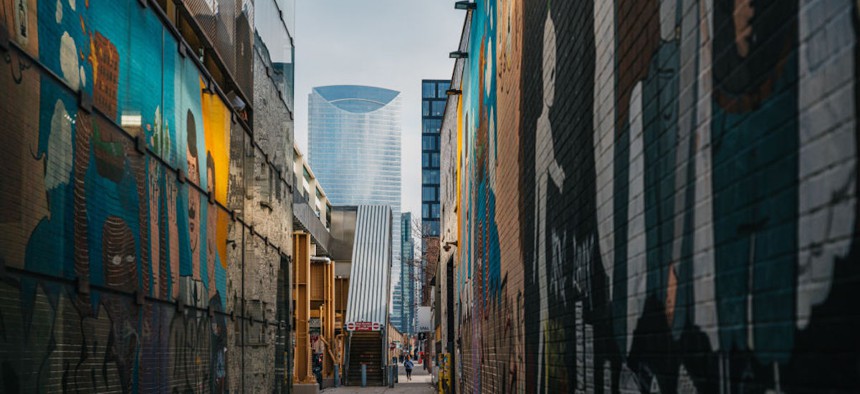City frames art as a way to bolster mental health services

Walls of murals line the Fulton Market neighborhood of Chicago, Illinois, on Ja. 8, 2023. Photo by Jamie Kelter Davis for The Washington Post via Getty Images
A pilot program in Chicago looks to address mental health workforce shortages, while exploring the benefits of holistic treatment through mediums like art.
Like many cities, Chicago is still grappling with two major issues stemming from the pandemic: job loss and worsened mental health. That’s why the city recently launched a pilot program to simultaneously address the two challenges.
The Arts & Health Pilot for Creative Workers creates a job training opportunity for professional artists who were disproportionately affected by the pandemic, and whose creative skills could help enhance mental health treatment and services in the city, said Meida McNeal, senior manager of arts and community impact investments at the Department of Cultural Affairs and Special Events.
Under the pilot, 10 participating artists will be paid a salary of $66,000 with benefits to complete a community health worker certification program through the city’s community college system and apprentice at one of five mental health clinics run by the Chicago Department of Public Health. Artists’ contracts last from June to December 2024.
Through the pilot, Chicago is looking to also “address some of the workforce shortages in behavioral health,” said Alisha Warren, assistant commissioner of mental health at the Department of Public Health. It could help ease the burden on the current workforce as well, she said, as the artists can supplement treatment services.
A recent survey from the National Council for Mental Wellbeing shows that 93% of behavioral health workers said they have experienced burnout, and 83% of respondents are concerned that workforce shortages will negatively impact society as a whole.
In addition to addressing these workforce shortages, Warren said the pilot recognizes “that there’s a lot of different ways that [mental health] healing takes place.” As research shows, more holistic approaches to mental and behavioral health, such as art, music or physical activity, can improve health outcomes for patients.
About $700,000 in American Rescue Plan Act funds are being used to support the artists’ training and certification, McNeal said. The program is also supported by a grant from FGC, a Builders Initiative Foundation Entity.
As a certified community health worker, participants are not qualified to provide mental health treatment such as therapy or medical prescriptions, she said. Rather, they will be “liaisons” of the city’s mental health clinics to educate community members on available resources and services.
Artists will also help clinical teams plan creative strategies to improve mental health care delivery. The selected participants cover a range of creative mediums, including art, dance, literary work or sound healing. This, Warren said, will allow clinics to explore the impacts on public health of different methods. For instance, artists could paint a mural at a health clinic to make the space seem more personable or conduct artistic workshops to encourage client participation in the city’s mental health services.
Chicago is part of a cohort of cities chosen by the National League of Cities to participate in an effort to infuse the arts into behavioral and mental health treatment from One Nation/One Project, or ONOP, a national initiative advocating for the advantages of art-based healing. Other cities conducting similar pilot programs include Edinburg, Texas; Gainesville, Florida; Harlan County, Kentucky; Phillips County, Arkansas; Providence, Rhode Island; Rhinelander, Wisconsin and Utica, Mississippi.
ONOP will help cities collect data on the effectiveness of the pilot programs, Warren said, such as providing survey templates for community feedback. Those insights could help officials determine how to adjust the program in the future to best suit residents’ needs.
“Our overall goals now are to improve people’s … mental health,” Warren said, “and to think about mental health in a more holistic way and [consider] all of the things that contribute to a person’s overall wellness.”






